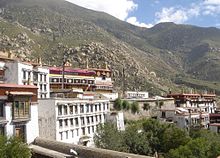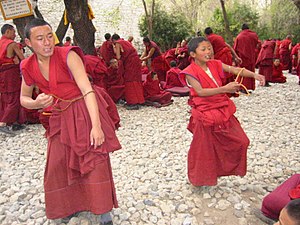Drepung Monastery
| Drepung Monastery | |
|---|---|
Tibetan transcription(s) Tibetan: འབྲས་སྤུངས་ Wylie transliteration: ’bras spungs Pronunciation in IPA: [[ˈtʂɛpuŋ]] Official transcription (China): Zhaibung THL: Drepung Other transcriptions: Dräpung[citation needed], Drebung[citation needed] Chinese transcription(s) Traditional: 哲蚌寺 Simplified: 哲蚌寺 Pinyin: Zhébàng Sì | |
 Drepung Monastery | |
| Religion | |
| Affiliation | Tibetan Buddhism |
| Sect | Gelug |
| Deity | Je Tsongkhapa |
| Location | |
| Location | Mount Gephel, Lhasa, Tibet Autonomous Region, China |
| Country | China |
Location within Tibet Autonomous Region | |
| Geographic coordinates | 29°40′35″N 91°2′51″E / 29.67639°N 91.04750°E |
| Architecture | |
| Founder | Jamyang Chojey |
| Date established | 1416 |
| Part of a series on |
| Tibetan Buddhism |
|---|
 |
Drepung Monastery (Tibetan: འབྲས་སྤུངས་དགོན་པ, Wylie: bras spungs dgon pa, THL: drépung gönpa,[1] "Rice Heap Monastery"),[2][3] located at the foot of Mount Gephel, is one of the "great three" Gelug university gompas (monasteries) of Tibet. The other two are Ganden Monastery and Sera Monastery.
Drepung is the largest of all Tibetan monasteries and is located on the Gambo Utse mountain, five kilometers from the western suburb of Lhasa.
Freddie Spencer Chapman reported, after his 1936–37 trip to Tibet, that Drepung was at that time the largest monastery in the world, and housed 7,700 monks, "but sometimes as many as 10,000 monks."[4][5]
Since the 1950s, Drepung Monastery, along with its peers Ganden and Sera, have lost much of their independence and spiritual credibility in the eyes of Tibetans since they operate under the close watch of the Chinese security services.[citation needed] All three were re-established in exile in the 1950s in the state of Karnataka in south-west India. Drepung and Ganden are in Mundgod and Sera is in Bylakuppe.
History
[edit]
Drepung Monastery was founded in 1416 by Jamyang Choge Tashi Palden (1397–1449), one of Tsongkhapa's main disciples, and it was named after the sacred abode in South India of Shridhanyakataka.[6] Drepung was the principal seat of the Gelugpa school and it retained the premier place amongst the four great Gelugpa monasteries.[7] The Ganden Phodrang (dga´ ldan pho brang) in Drepung was the residence of the Dalai Lamas until the Great Fifth Dalai Lama constructed the Potala. Drepung was known for the high standards of its academic study, and was called the Nalanda of Tibet, a reference to the great Buddhist monastic university of India.
Old records show that there were two centres of power in Drepung: the so-called lower chamber (Zimkhang 'og ma)[8] associated with the Dalai Lamas-to-be, and the upper chamber (Zimkhang gong ma) associated with the descendants of Sonam Drakpa, an illustrious teacher who died in 1554.[9] The estate of the Dalai Lamas at Drepung Monastery, called Ganden Phodrang, had been constructed in 1518 by Gendun Gyatso Palzangpo (1476–1541), retrospectively named and counted as 2nd Dalai Lama. The name of the Tibetan government established by the 5th Dalai Lama came from the name of this estate.
Penchen Sönam Drakpa (1478-1554 CE) in 1535 succeeded Gendün Gyatso (1476–1541) on the Throne of Drepung, both of them being major figures in the history of the Geluk tradition. By the time Sönam Drakpa was appointed to the Throne of Drepung (Drepung Tri), he was already a famous Geluk master. He had already occupied the Throne of Ganden (Ganden Tri) and was considered the most prolific and important Geluk thinker of his time. His successor was none other than Sönam Gyatso (1543-1588 CE), the lama who would receive the official title of the Third Dalai Lama (Talé Lama Kutreng Sumpa).
Before his death in 1554, Sönam Drakpa established his own estate, the Upper Chamber (Zimkhang Gongma), which was named because of its location at the top of Drepung, just below the Ngakpa debating courtyard "Ngagpa Dratshang".
Tibetan Buddhist Resource Center attributes the following Name variants to Penchen Sönam Drakpa: "bsod nams grags pa [primaryName], paN chen bsod nams grags pa [title], khri 15 bsod nams grags pa [primaryTitle], rtses thang paN chen bsod nams grags pa [title], gzims khang gong ma 01 bsod nams grags pa [title], this last one referring to the Seat of the Upper Chamber established in 1554.[10] According to TBRC his successors referring to the estate of the Zimkhang Gongma were Sonam Yeshe Wangpo (1556–92),[11] Sonam Gelek Palzang (1594–1615)[12] and Tulku Dragpa Gyaltsen (1619–1656)[13] - closely connected to the famous story of Dorje Shugden. (Some say[citation needed] that Drakpa Gyeltsen was Sönam Drakpa’s second reincarnation,[14] but usually he is considered to be the 4th incarnation of Panchen Sonam Dragpa).[15] It seems to be commonly accepted that Dragpa Gyaltsen was the fourth holder of the gzims khang gong ma incarnation line. According to Tibetan Buddhist Resource Center gzims khang gong ma 04 grags pa rgyal mtshan has been his "primaryTitle".[16] Since the search for his reincarnation has been banned, he has been the last one.
Chapman reported that in the late 1930s Drepung was divided into four colleges, each housing monks from a different locality: "one being favoured by Khampas, another by Mongolians, and so on." Each college was presided over by an abbot who had been appointed by the late 13th Dalai Lama.[17]
Drepung is now divided into what are known as the seven great colleges: Gomang (sGo-mang), Loseling (Blo-gsal gling), Deyang (bDe-dbyangs), Shagkor (Shag-skor), Gyelwa (rGyal-ba) or Tosamling (Thos-bsam gling), Dulwa (‘Dul-ba), and Ngagpa (sNgags-pa). It can be a somewhat useful analogy to think of Drepung as a university along the lines of Oxford or the Sorbonne in the Middle Ages, the various colleges having different emphases, teaching lineages, or traditional geographical affiliations.
According to local sources[citation needed], today the population at the monastery in Lhasa is about 300 monks, due to population capping enforced by the Chinese government. However, the institution has continued its tradition in exile with campuses in South India on land in Karnataka given to the Tibetan community in exile by Prime Minister Jawaharlal Nehru. The monastery in India today houses over 5,000 celibate monks, with around 3,000 at Drepung Loseling and some 2,000 at Drepung Gomang. Hundreds of new monks are admitted each year, many of them refugees from Tibet.
The Ganden-Phodrang-Palace situated at Drepung Monastery was constructed by the 2nd Dalai Lama in 1518[18] and declared his chief residence/governmental palace until the inauguration of Potala Palace by the 5th Dalai Lama.
Recent events
[edit]Almost half of the older monastic buildings was destroyed after the Chinese arrived in Lhasa in 1951. The chief buildings including the four colleges, the Tsokchen, and the Dalai Lamas' residence were preserved.[7]
The first reported demonstration during the 2008 Tibetan uprising anniversary was on 10 March 2008, when a group of 300-400 monks from Drepung monastery marched to Lhasa's center demanding religious freedom and the release of Drepung monks arrested a year earlier. Chinese police blocked their route, and a sitting protest began. Reportedly, some monks were thrown to the ground and kicked,[19] and up to 60 monks were arrested.[20][19]
Drepung monastery was under siege four days later by Chinese forces, on 14 March 2008. Reports state forces had blocked off water, electricity, food and health facilities in Drepung Monastery and at other monasteries active in the demonstrations, including Ganden and Sera monasteries. As a consequence, monks were suffering starvation.
After the 7 April 2008 foreign press tour by Chinese authorities, 80 monks had disappeared from Drepung[21] and two from Labrang had disappeared for speaking out to reporters.
The International Herald Tribune reported that Drepung Monastery reopened in 2013 after being shut for five years.[22]
Gallery
[edit]-
Young monks debating at Drepung
-
Monks in the great assembly hall, 2006
-
Monks chanting, 2013
-
Thankas painted on the walls of Drepung
-
Monastery kitchen, 2013
-
Ganden Phodrang, the Dalai Lama's residence
-
Destroyed buildings at Drepung, 1993
Footnotes
[edit]- ^ TBRC
- ^ Tibet, Tibet: A Personal History of a Lost Land. Patrick French. (2003) Alfred A. Knopf. New York City, p.240 (in quote from 13th Dalai Lama).
- ^ Dialogues Tibetan Dialogues Han. Hannue. Quoting a monk at Drepung.
- ^ Chapman F. Spencer. Lhasa the Holy City, p. 195. Readers Union Ltd., London.
- ^ "What we don't hear about Tibet" Archived 2017-12-14 at the Wayback Machine, The Guardian (Comment is Free). (Wednesday 11 February 2009 22.00 GMT)
- ^ Dorje (1999), p. 113.
- ^ a b Dowman (1988), p. 67.
- ^ gong ma 'og ma - the higher and the lower, the one above and the one under
- ^ "Why the Dalai Lama Rejects Shugden". Archived from the original on 1999-10-10.
- ^ TBRC[dead link]
- ^ TBRC bsod nams ye shes dbang po (gzims khang gong ma 02)[dead link]
- ^ TBRC bsod nams dge legs dpal bzang (gzims khang gong ma 03)[dead link]
- ^ TBRC grags pa rgyal mtshan (gzims khang gong ma 04)
- ^ Drepung: An Introduction by Georges Dreyfus (April 10, 2006)[dead link]
- ^ "Brief History of Ganden Monastery". StudyBuddhism.com. 2012-11-21. Archived from the original on 2016-09-01. Retrieved 2016-06-05.
- ^ TBRC
- ^ Chapman F. Spencer. Lhasa the Holy City, p. 198. Readers Union Ltd., London.
- ^ Karl-Heinz Everding. Tibet. Kunst-Reisefόhrer: Lamaistische Klosterkultur, nomadische ... Retrieved 2013-06-05.
- ^ a b "I saw it with my own eyes: Abuses by Chinese security forces in Tibet, 2008-2010". Human Rights Watch. 21 July 2010. Archived from the original on September 14, 2020.
- ^ Blanchard, Ben (11 March 2008). "Tibetan monk protest in Lhasa draws China's ire". Reuters. Retrieved 30 November 2020.
U.S. government-funded Radio Free Asia cited a source [...] "Authorities at a checkpoint along the way stopped and detained between 50 and 60 monks"
- ^ Nirmala Carvalho, More than a thousand monks and many civilians have disappeared since the March crackdown, 29 September 2009), http://www.asianews.it/index.php?l=en&art=13322&geo=6&size=A
- ^ Richards, Huw. "Major Buddhist monastery reopens in Tibet. The Associated Press". International Herald Tribune. Archived from the original on 2008-09-15. Retrieved 2013-06-05.
References
[edit]- Dorje, Gyurme. (1999). Footprint Tibet Handbook with Bhutan. 2nd Edition. Footprint Handbooks. Bath, England. ISBN 0-8442-2190-2.
- Dowman, Keith. (1988). The Power-places of Central Tibet: The Pilgrim's Guide. Routledge & Kegan Paul, London and New York. ISBN 0-7102-1370-0
- von Schroeder, Ulrich. 2001. Buddhist Sculptures in Tibet. Vol. One: India & Nepal; Vol. Two: Tibet & China. (Volume One: 655 pages with 766 illustrations; Volume Two: 675 pages with 987 illustrations). Hong Kong: Visual Dharma Publications, Ltd. ISBN 962-7049-07-7. ’Bras spungs («drepung») monastery: pp. 550, 705, 715, 830, 1004, 1005. bKra shis sgo mang grwa tshang («tashi gomang dratsang»), p. 824; Pls. 196A, 196B; Blo gsal gling grwa tshang («losaling dratsang»), p. 1005; Fig. XVI–4; Mi ’khrugs lha khang («mintrug lhakhang»), p. 824; Pls. 196A, 196B.
External links
[edit]- Bras-spungs monastery, Tibet, China Encyclopædia Britannica
- Official Website of Drepung Gomang Monastery
- A multimedia guide to Drepung
- Drepung Loseling Institute in North America
- A Brief History of Drepung Monastery
- Drepung: An Introduction by Georges Dreyfus (April 10, 2006)[permanent dead link]
- The Gomang College home page
- Tibet Lhasa Drepung Monastery Tour Blog by Chris
- Drepung Loseling video tour in 2006, Tibetan settlement in Mundgod, India
- Buildings and structures completed in 1416
- 15th-century Buddhist temples
- Chengguan District, Lhasa
- Buddhist temples in Tibet
- 1416 establishments in Asia
- Religious organizations established in the 1410s
- Buddhist monasteries in Lhasa
- Gelug monasteries
- Major National Historical and Cultural Sites in Tibet
- 1950s establishments in Mysore State
- Buildings and structures in Uttara Kannada district
- Buddhist temples in Karnataka
- Tibetan Buddhist monasteries and temples in India









